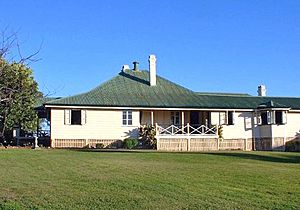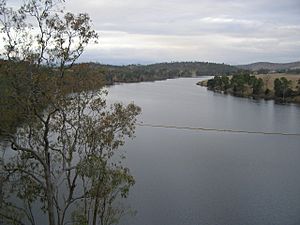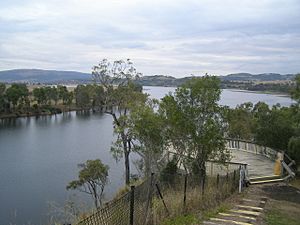Caboonbah Homestead facts for kids
Quick facts for kids Caboonbah Homestead |
|
|---|---|

Caboonbah homestead, 2009
|
|
| Location | Esk-Kilcoy Road, Lake Wivenhoe, Somerset Region, Queensland, Australia |
| Design period | 1870s - 1890s (late 19th century) |
| Built | 1889 - 1890 |
| Demolished | 10 May 2009 |
| Architectural style(s) | Arts & Crafts |
|
Former Queensland Heritage Register
|
|
| Official name: Caboonbah Homestead | |
| Type | state heritage (built) |
| Designated | 12 December 1996 |
| Delisted | 2014 |
| Reference no. | 601139 |
| Significant period | 1880s-1930s (historical) 1880s-1890s (fabric) |
| Significant components | furniture/fittings, views to, residential accommodation - main house, views from |
| Lua error in Module:Location_map at line 420: attempt to index field 'wikibase' (a nil value). | |
Caboonbah Homestead was an important old home in Queensland, Australia. It was located near Lake Wivenhoe in the Somerset Region. This large house was built between 1889 and 1890. It was listed on the Queensland Heritage Register in 1996, meaning it was a special historical place. Sadly, a fire destroyed the homestead in 2009. It was then removed from the heritage list in 2014.
Contents
History of Caboonbah Homestead
Building a New Home
Caboonbah Homestead was built for Henry Plantagenet Somerset and his wife, Katherine Rose. They started building it in 1889 and finished in 1890. Henry Somerset came to Queensland from England in 1871. He was 19 years old. He planned to join the army, but instead, he started working with livestock.
In 1879, Henry married Katherine Rose McConnel. Her father, David Cannon McConnel, was a pioneer in the Brisbane Valley. Henry had learned a lot about managing a station from Katherine's family.
Choosing the Location
In the 1880s, Henry Somerset bought about 20,000 acres of land. This was in the Mount Stanley area. He wanted to build his family home there. He even started making bricks for the chimneys.
However, Katherine's family, the McConnels, wanted to be closer. They didn't want to cross 19 rivers to visit. So, Henry traded some of his land for 5,000 acres from the McConnels. This new land was at the meeting point of the Brisbane and Stanley Rivers.
Henry called this new property Caboonbah. This name came from an Aboriginal phrase meaning "big rock." It described the tall, 120-foot high bank of the Brisbane River where the homestead was built. The land was very fertile. It was used for raising cattle, dairy farming, and horse breeding.
Construction and Family Life
Work on Caboonbah Homestead began in late 1889. It was finished during the floods of 1890. Bricks were made nearby for the service buildings. But stronger bricks from Dinmore were used for the house chimneys.
Most of the house was built with timber from a mill near Villeneuve. Some pine from Mount Stanley was used for the loft. The roof was made of shingles. The Somerset family moved into their new home in March 1890.
They lived there until Katherine passed away in 1935. Henry died the next year. Two of their ten children were born at Caboonbah. Two of their children are buried on the slope near the house.
Caboonbah as a Flood Warning Station
During the huge 1893 Brisbane floods, Henry Somerset was in a unique position. He could see the river rising quickly from Caboonbah. He knew the danger this posed to other towns.
When 36 inches of rain fell in the Blackall Range in February 1893, the river rose to 74 feet at Caboonbah. Henry sent a messenger on horseback to Esk. The messenger telegraphed Brisbane to warn them.
Two weeks later, the river rose again. The telegraph line to Esk was down. So, Henry rowed across the flooded Brisbane River. He had two horses swimming behind him. He sent a rider across the d'Aguilar Range to Caboolture. From there, another telegram was sent to Brisbane.
Because of Henry's efforts, Caboonbah became Queensland's first flood warning station. A telegraph line was set up to Cressbrook Station. The Somerset family operated this station for 40 years, from 1893 to 1933, without pay.
Community Contributions
Both Henry and Katherine Somerset were very active in their community. Henry was a member of the Esk Divisional Board. He later became its chairman. Katherine helped start the Stanley Memorial Hospital.
In 1905, the Somersets founded the Caboonbah Undenominational Church. They donated the land and timber for it. Before the church was built, Henry held services every second Sunday. Katherine played the organ.
From 1904 to 1920, Henry Somerset was a Member of the Legislative Assembly for the Stanley area. He helped extend the Brisbane Valley railway line to Blackbutt and Yarraman. He also supported rural schools. The area of Stanley was later named Somerset in his honor.
The Somerset Dam
Henry Somerset was also the first person to suggest the site for the Somerset Dam. This dam was later named in his honor. After the 1893 floods, people wanted to control the Brisbane River.
In 1906, Henry suggested building a dam across the Stanley Gorge. He believed it could help with floods and provide water for Brisbane. An American engineer, Allan Hazen, agreed the site was good.
Work on the dam began in 1935. It was a big project to create jobs during the Great Depression. In 1935, people asked for the dam to be named Somerset. The town built for the dam workers was also named Somerset.
The dam was mostly built by 1941. But work stopped during World War II. The dam officially opened in 1953. In 1958, Queensland Premier Frank Nicklin unveiled a plaque. It officially named the dam after Henry Plantagenet Somerset.
Later Years and Destruction
After Katherine Somerset died in 1935, the homestead was sold. The Grieve family bought it and ran it as a guest house until 1962. In 1963, Neville Carseldine bought it as a private home.
In 1973, the Queensland Government took over the property. This was part of the Wivenhoe Dam project. The Brisbane Valley Historical Society later took care of the homestead. They restored it carefully. Caboonbah Homestead opened to the public in 1989.
In 2000, a movie called Deluge told the story of Henry Somerset and the 1893 flood. Sadly, Caboonbah Homestead burned down on May 10, 2009.
Description of Caboonbah Homestead
Caboonbah Homestead was a large, single-story timber house. It sat on a high bank of the Brisbane River. The house overlooked Lake Wivenhoe. It was built on timber stumps. Its frame was made of hardwood.
The house had timber verandahs on the north, east, and south sides. The roof was made of galvanised iron. This was placed over the original timber shingles.
The homestead had been made larger over time. A big entrance porch was added on the eastern side. This addition likely happened in the 1920s.
The original house had a central hallway. There were four main rooms, a service wing, and verandahs. Some parts of the verandahs were enclosed to make small rooms. A new wing was added to the back of the house. This wing also seemed to be from the 1920s.
Inside, the homestead kept many original features. These included cedar frames around the fireplaces. The dining room had a special coved timber ceiling.
Next to the house, on the western side, was a masonry service building. It had a concrete floor and walls made of handmade bricks. It had a corrugated iron roof.
Why Caboonbah Homestead Was Important
Caboonbah Homestead was listed on the Queensland Heritage Register because it met several important criteria.
Showing Queensland's History
Caboonbah Homestead was important for showing how Queensland's history developed. It was linked to the first flood warning station in Queensland, set up in 1893. The place was also connected to local social and political events. It showed the power of the Queensland Government in the Stanley area from 1904 to 1920.
Unique Design and Features
The homestead was a great example of a large timber house from the late 1800s. It also had additions from the early 1900s. Its design showed how people adapted British architectural styles to Queensland's climate. It had wide, low verandahs where every room opened. It also had high ceilings and fanlights above French doors.
Special Connection to the Community
Caboonbah Homestead had a special meaning for the local community. It was important for the early development of the Caboonbah area. It was also linked to state politics in the Stanley (now Somerset) area for 16 years. The homestead was also connected to the building of the Somerset Dam. This was one of Queensland's most important projects in the mid-1900s.
Association with Important People
Caboonbah Homestead was strongly linked to the lives of Henry Plantagenet Somerset and his wife, Katherine Rose McConnel. They lived there from 1890 until Katherine's death in 1935. The Somersets were very important in the Brisbane Valley and Queensland from 1890 to 1920. Henry Somerset is especially remembered for setting up Caboonbah as Queensland's first flood warning station. He also chose the site for the Somerset Dam, which was named in his honor.



